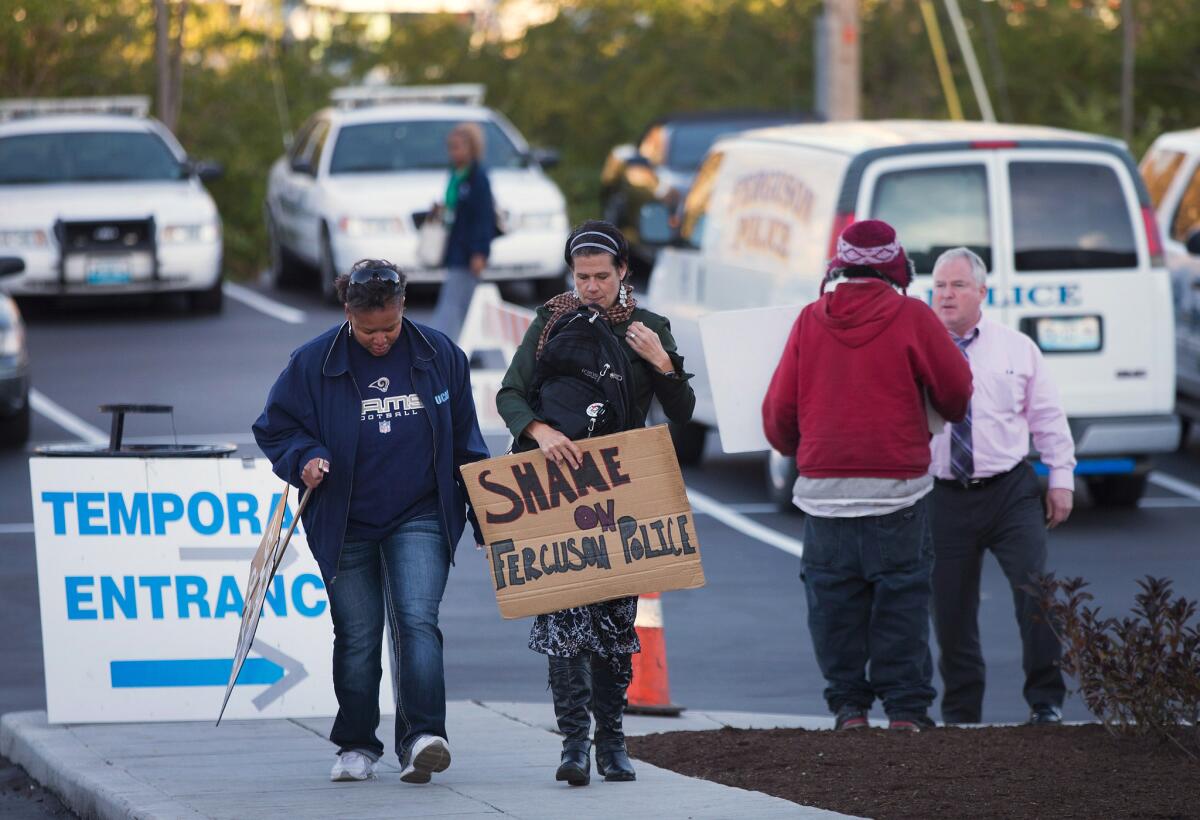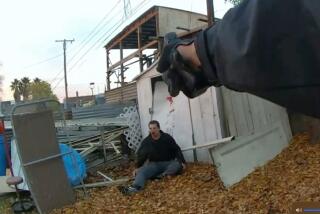Back Story: What happened in Michael Brown shooting in Ferguson, Mo.?

St. Louis County officials announced Monday night that a grand jury had declined to indict Ferguson, Mo., Police Officer Darren Wilson in the shooting of Michael Brown. Here’s what we know about the deadly encounter.
What’s the police version of events?
Wilson has not spoken publicly about what happened, and no direct video of the shooting has surfaced. According to a preliminary police account, which was included in Brown’s official autopsy report, the confrontation began when Wilson, on patrol, spotted Brown and a friend, Dorian Johnson, walking in the street.
Wilson “observed the two individuals, he requested that they get out of the roadway. The deceased became belligerent towards Officer Wilson,” the report stated. It continues:
“As Officer Wilson attempted to exit out of his patrol vehicle the deceased pushed his door shut and began to struggle with Officer Wilson, during the struggle the Officer’s weapon was un-holstered. The weapon discharged during the struggle.
“The deceased then ran down the roadway. Officer Wilson then began to chase the deceased. As he was giving chase to the deceased, the deceased turned around and ran towards officer Wilson.”
Wilson then fired “several times,” the report said. (Police have not said exactly how many times Wilson fired his gun.) Official and private autopsies both appeared to show that Brown was shot at least six times during the encounter.
What does Brown’s friend say happened?
Johnson says that when the incident began, Wilson used profanity to tell the young men to get out of the street, hit Brown with his car door while trying to open it, then grabbed Brown by the neck.
“They’re not wrestling so much as his arm went from his throat to now clenched on his shirt,” Johnson told MSNBC. “It’s like tug of war. He’s trying to pull him in. He’s pulling away, that’s when I heard, ‘I’m gonna shoot you.’”
After the first shot wounded Brown, Johnson said, Brown ran and Wilson chased him. Wilson then shot Brown in the back, and Brown stopped, turned with his hands up, and said, “I don’t have a gun, stop shooting!” according to Johnson’s account to MSNBC.
As Wilson stood face-to-face with Brown, the officer shot him several more times, Johnson said.
Is Johnson the only witness who has said Brown had his hands up when he was shot?
No. Among the earliest details to provoke fury from residents and demonstrators were witnesses’ statements to the media that Brown had his hands raised in surrender when Wilson shot him.
One witness, Tiffany Mitchell, told MSNBC that Wilson shot at Brown as he was running away, and Brown’s body jerked as if he had been shot. Mitchell said Brown “turned around and put his hands up, and the officer continued to walk up on him and shoot him until he goes all the way down to the ground.” Another witness, Piaget Crenshaw, gave a similar account.
Johnson has testified before the grand jury, but it’s unclear whether Crenshaw or any other witnesses who say Brown was trying to surrender have done so.
The Washington Post sparked controversy last month when it reported that several black witnesses had provided testimony to the grand jury that largely supported Wilson’s account of events.
Who is investigating the case?
The Ferguson Police Department almost immediately turned over the investigation to the St. Louis County Police Department. Longtime St. Louis County prosecutor Robert McCulloch convened a grand jury to decide whether Wilson broke the law.
The involvement of McCulloch, who is white, upset some demonstrators and black community members who questioned his impartiality and called on him to withdraw. McCulloch’s father, a policeman, was shot and killed by a suspect during a chase on foot in 1964.
McCulloch refused to step aside, but promised a thorough investigation in which grand jury members would review all the evidence in the case rather than hearing from just a few key witnesses, who include Wilson. (A prosecutor’s spokesman confirmed that more evidence was being presented to the grand jury for the Ferguson case than was typical, but he did not elaborate.)
After the grand jury’s decision is released, McCulloch’s office has promised to release all evidence and testimony from the proceedings, which are conducted in secret. The prosecutor probably would have to seek a judge’s approval for such a move, and if there is an indictment, some of the information might remain confidential until trial.
Is the federal government investigating?
Yes. The Justice Department launched a civil rights investigation into the shooting, and evidence gathered by federal officials has been shared with the St. Louis County grand jury.
More than 40 FBI agents canvassed the neighborhood where Brown was shot, and federal officials conducted their own autopsy on Brown’s body in addition to two others — one by local officials, the other at the behest of Brown’s family.
Federal officials’ involvement has not been without controversy. Some local officials have accused them of leaking grand jury information to the media. The leaks have tended to buttress Wilson’s version of events.
Conversely, the Justice Department has criticized Ferguson police for its release of footage of Brown physically intimidating a convenience store clerk shortly before the shooting. In a strongly worded statement last month, a Justice Department spokeswoman said that “there seems to be an inappropriate effort to influence public opinion about this case.”
The St. Louis County prosecutor’s office denied being the source of the leaks and said it did not suspect the grand jurors of leaking either.
The Justice Department also is conducting a broader investigation into the practices of the Ferguson Police Department and other police agencies in the area after demonstrators and residents complained about racial profiling and harassment.
What does Missouri law say about when officer-involved shootings are legal?
Missouri law provides wide latitude for police to use deadly force, particularly if the officer believes it’s necessary to protect his or her safety or the safety of others.
But, Washington University law professor Peter Joy said, “If Michael Brown was trying to surrender at the time, that makes this defense not applicable. So the question is: Was Michael Brown clearly trying to surrender at the time that the fatal gunshots were fired?”
Joy said a federal indictment seemed unlikely, at least according to the publicly reported accounts of the shooting thus far.
“That would require that Officer Wilson intentionally planned or intentionally meant to violate the civil rights — that is, take the life of — Michael Brown because of his race,” Joy said.
Twitter: @mattpearce
More to Read
Sign up for Essential California
The most important California stories and recommendations in your inbox every morning.
You may occasionally receive promotional content from the Los Angeles Times.











